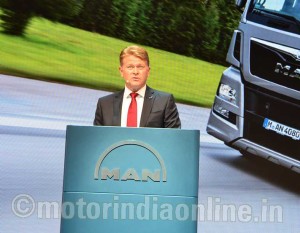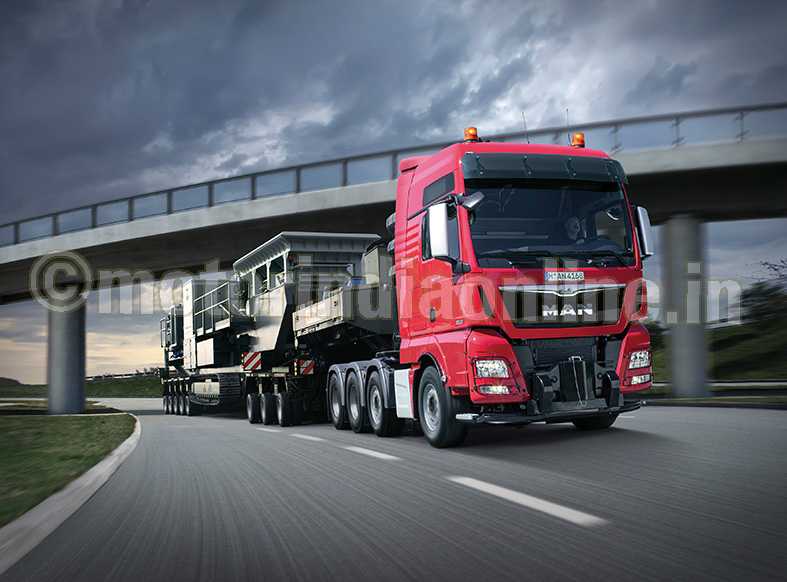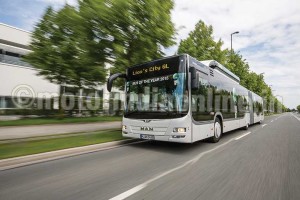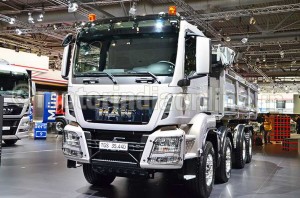Prime focus on fuel saving, safety
MAN presented a wide range of state-of-the-art trucks and buses at IAA in Hanover. Fuel efficiency was the central theme of the new models that MAN showcased. Innovative technology has reduced fuel consumption on the part of trucks and buses, resulting in lower running costs on the one hand and fewer emissions on the other.
At IAA, attention centred on the its top-of-the-range TGX D38 truck, which celebrated its public debut. Delivering outputs of 520, 560 and 640 hp, the new flagship rounded off the high end of MAN’s family of vehicles.
This top model offers a tailored powertrain with numerous new efficiency features and is pre-destined for demanding transport tasks. At the heart of the vehicle lies the newly developed D38 six-cylinder inline engine with a displacement of 15.2 litres. This power unit stands for masterful power delivery, equipping the TGX D38 with maximum traction to meet all needs – without striving to break any records in terms of horsepower. Instead, MAN engineers have focused their attention on reliability, efficiency and low running costs.
The new MAN TGX EfficientLine 2

The new MAN TGX EfficientLine 2 also reflects this philosophy. All efficiency technologies are included as standard on-board features, notably predictive EfficientCruise cruise control, torque-enhancing TopTorque and a more powerful version of MAN TeleMatics. MAN’s TGX EfficientLine is the most successful model on the market, being systematically designed to save fuel. Since their market launch in 2010, more than 27,000 customers have opted for highly economic EfficientLine models and packages.
By installing EfficientCruise in all heavy-duty trucks, as well as coaches, MAN makes a significant contribution to reducing CO2 in commercial vehicles. This GPS-based cruise control calculates approaching upward or downward inclines by analyzing 3D map data and the position of the vehicle. It predicts and automatically controls the speed required on uphill and downhill stretches in such a way that the vehicle’s momentum is used to save fuel. Using this system, a fully-loaded 40-ton truck can realize fuel savings of up to six percent, without losing any time en route.
Together with other efficiency technologies, such as torque-enhancing TopTorque or the special gearbox functions offered by MAN’s TipMatic 2, customers have access to a wide range of fuel-saving technologies.
“Prize” buses
MAN also presented a new version of its top bus model, the NEOPLAN Skyliner. From June 2015, a Euro 6 version of this coach will be available, which will then have the lowest CO2 emissions per passenger in this class of vehicles. With its award-winning design, the double-decker offers seating for up to 83 people. The model shown at the fair is fully accessible and offers two spaces for wheelchair users.
Also on show was the newly-acclaimed Bus of the Year 2015, the MAN Lion’s City GL CNG. This natural gas-powered city bus impressed the jury of international trade journalists with its extremely eco-friendly, powerful, yet economic drive system. Natural gas buses are not only more environmentally-benign than diesel-powered buses, but are also approx. 15 per cent cheaper to maintain and operate over their entire life cycle.
Finally, MAN provided visitors to the fair with a glimpse into the future of commercial vehicles. Based on the MAN TGX Hybrid concept, MAN for the first time showed a hybrid-drive system for long-distance transport. In this case, a diesel engine acts as the primary source of power, while an additional drive system operated by an electric motor opens up the possibility of recovering, storing and reusing braking energy.
Most freight kilometers are driven on long-haul stretches, so that, compared with all other hybrid vehicle applications, the overall potential for reducing CO2 is the largest in this sector. Since the electric motor serves merely as a back-up for the diesel engine, this gives rise to a lean, weight-saving system whose hybrid components weigh about 400 kg.
In the case of distribution transport, however, other forms of drive offer a preferable alternative. As a result, MAN is expanding its portfolio of CNG vehicles, and from 2014 onwards, will also be adding trucks with CNG drive to its existing range of natural-gas-powered city buses.
At IAA 2014, MAN offered a preview of CNG technology in trucks based on a TGM distribution chassis. These vehicles can, for instance, be used in the municipal sector, as delivery vehicles in the retail trade or as parcel delivery trucks. The advantages offered, especially in urban areas, include the fact that trucks powered by natural gas are not only much more eco-friendly, but also quieter.
A TGM with CNG drive is up to 3dB(A) quieter in terms of both interior noise and pass-by noise during acceleration. This figure means that for human ears the vehicle is about half as loud. And, as in the case of buses, the benefits of economic efficiency also have an impact, with fuel costs falling by up to 35 per cent.
For added safety
Based on many years of accident research, MAN has specifically improved the active safety of its trucks and buses. This has given rise to today’s assistance systems that are available as standard features and support drivers in precisely those situations which have proved to be the most frequent causes of accidents, namely, Adaptive Cruise Control (ACC), Emergency Brake Assist (EBA) and Lane Guard System (LGS).
Apart from the systems already available as standard features on show at the IAA, MAN researchers also offered a preview of systems on which they are currently focusing with the aim of supporting drivers in other accident-prone driving situations. These will act as an extended “electronic eye” for the driver who, from the cabin, has no direct view of certain points around his vehicle.
All these systems are conceptual prototypes illustrating the present status of MAN’s research in the field of active safety. They include a lane change assistant for multi-lane highways, a turn-off assistant for turning right in urban traffic, as well as a camera system which, in future, will replace a number of various side mirrors and be able to combine the surrounding traffic flow into a single picture.
MAN Solutions stands for a service network offering customers valuable opportunities to reduce costs. At IAA, MAN displayed numerous innovations in this sector, one example being the new Connected CoDriver service provided by MAN ProfiDrive. This consists of distance training over periods of between one week and three months, during which a trainer supports the driver by essentially acting as a virtual co-driver.


